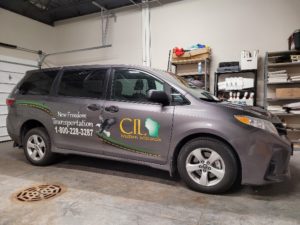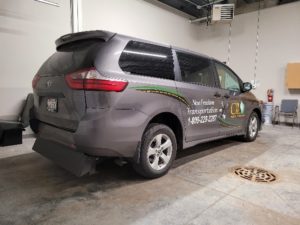 During the month of February, we recognized Black History month and on February 3rd specifically acknowledged the contributions of civil rights icon Rosa Parks on what would have been her 107th birthday. Parks’s role in initiating the Montgomery Bus Boycott can also be considered the beginning of a greater movement for accessible transportation options for All Americans – including those with disabilities. In this week’s blog Kyle Kleist, Executive Director of the Center for Independent Living of Western Wisconsin (CILWW) and NAB Member Billy Altom, Executive Director of the Association of Programs for Rural Independent Living (APRIL), walk us through some of the issues and barriers to accessible transportation as well as some of the methods to make transport accessible to all.
During the month of February, we recognized Black History month and on February 3rd specifically acknowledged the contributions of civil rights icon Rosa Parks on what would have been her 107th birthday. Parks’s role in initiating the Montgomery Bus Boycott can also be considered the beginning of a greater movement for accessible transportation options for All Americans – including those with disabilities. In this week’s blog Kyle Kleist, Executive Director of the Center for Independent Living of Western Wisconsin (CILWW) and NAB Member Billy Altom, Executive Director of the Association of Programs for Rural Independent Living (APRIL), walk us through some of the issues and barriers to accessible transportation as well as some of the methods to make transport accessible to all.
NAB: Why is accessible transportation so important (especially in rural communities)?
KK: There is a lack of affordable and accessible transportation in most rural areas across the US. Without access to transportation, persons with and without disabilities are unable to engage in and be part of their community. This is especially true in Wisconsin where a majority of the state would be classified as rural.
NAB: Haven’t ride share options like Uber and Lyft addressed transport in most places?
KK: Not at all in rural areas like ours. For people with visual disabilities or other disabilities that can use Uber and Lyft, ridesharing has helped in cities — where they’re available. Unfortunately, rural areas and the outskirts of smaller urban cities often lack Uber or Lyft operators to assist with transportation. In these areas, there are very few Uber and Lyft providers – and that’s for standard transport. In rural Wisconsin, I am not aware of any that operate an accessible or lift equipped vehicle. Outside of cities operating bus services, which would be required to provide paratransit, and smaller cities operating Rideshare programs that only operate within city limits, there are few transportation options for people who need lift equipped vans. The services that are available are often only available at a high cost, or only appropriate for medical emergencies and not flexible enough to support day to day transport needs
National Advisory Board Member Billy Altom is the Executive Director of the Association of Programs for Rural Independent Living (APRIL). Billy offers this context to understand how accessible transportation and programs like the one offered by CILWW are a national issue. He notes, “Accessible transportation has always been an issue for the Disability community. While Justin and Yoshiko Dart often had to travel in ambulances and vans as they completed their Road to Freedom tour, new transportation options such as ride-share and accessible taxis have offered more freedom to the next generation of individuals with disabilities. As accessibility increases, important conversations about cost and the personal choice of accessing transportation have begun to be a common discussion across the country. Non-emergency medical transportation (NEMT) is an important benefit for people who need assistance getting to and from medical appointments. Not only are individuals with disabilities demanding equal access to the same transit options as everyone else, many localities are also realizing the excessive cost of using inaccessible systems to provide transportation options that do not work for all their residents. In the Tennessee Carriers program in Memphis, not only has the county partnered with rideshare services to create an accessible transit solution, they have also learned that they save money and resources when resources are tailored. Emergency transit is used for emergencies and non-emergency and regular transit is planned and accessible. The Department of Health and Human Services has even begun offering guidance on how to provide these important services.”
 KK: The Center for Independent Living of Western Wisconsin has launched the “New Freedom” transportation program. The program which began in 2004 as a small pilot voucher program is funded through an area foundation with the primary purpose of assisting transit-dependent persons, especially those with disabilities living in rural areas, in accessing and being part of their community. Initially vouchers were used to assist people with disabilities to reimburse family, neighbors, friends or others to provide them with transportation, and they were reimbursed at the federal mileage rate.
KK: The Center for Independent Living of Western Wisconsin has launched the “New Freedom” transportation program. The program which began in 2004 as a small pilot voucher program is funded through an area foundation with the primary purpose of assisting transit-dependent persons, especially those with disabilities living in rural areas, in accessing and being part of their community. Initially vouchers were used to assist people with disabilities to reimburse family, neighbors, friends or others to provide them with transportation, and they were reimbursed at the federal mileage rate.
NAB: What have you found is the most important need that the program was able to address?
KK: The most important need the program was able to serve was transportation other than medical. So many people with disabilities both needed and wanted transportation for a variety of reasons other than medical appointments. This included trips to the grocery store, hair appointments, and a number of other activities that we call “social or recreational” trips. The emphasis of the program all along has been to provide transportation so that everyone can be part of their community. We soon realized that not everyone had someone that could assist with transportation, so we began recruiting drivers to meet this need, once again reimbursing them at the federal level.
 NAB: Where do your drivers come from? Are they professionals or gig economy drivers like in rideshare programs?
NAB: Where do your drivers come from? Are they professionals or gig economy drivers like in rideshare programs?
KK: The New Freedom Transportation Program is strictly a volunteer driver program. With 160 volunteer drivers, they have provided 30,057 rides in 2019 totaling 1,388,160 miles and 510,019 hours. New Freedom Volunteer Drivers provided flexible and affordable transportation 24 hours a day 7 days a week. New Freedom Transportation is not limited to just medical rides; our program provides transport for Medical, Employment, Education/Training, Social/Recreation, Shopping/Independent Living and Nutrition activities. Drivers can also provide rides that cross state lines and boundaries that other programs cannot. New Freedom has been recognized as a model program and has expanded from 10 counties in the beginning to 42 counties across Wisconsin. It has become the largest volunteer driver program in the country.
NAB: Many ride-share and taxi services cannot adequately support people with mobility disabilities — especially if they use heavy mobility devices. How do you address this?
KK: We have two lift-equipped vans that have a 42” wide ramp rather than the standard 36” wide ramp and are equipped with a “beefed up” suspension so they can accommodate up to 1,200 pounds. These vans are on the road constantly being driven by volunteer drivers they meet an essential need for people that use mobility devices since many of our volunteer drivers don’t personally own a lift-equipped vehicle.
NAB: Have there been unexpected benefits to the program?
KK: Initially the program was funded through federal and foundation dollars. Over time as counties and other agencies saw the benefit of a volunteer driver program and the ability to meet the needs of the people they work with, our Center began contracting with counties to assist with providing trips for older adults and people with disabilities through the State 85.21 program. Most recently the Center has begun contracting with two Managed Care Organizations (MCOs) in 47 counties in the State of Wisconsin, as well as participants in the Medicaid funded self-directed IRIS program in several counties as well.
NAB: How do caregivers factor into the resource? Can they use the program to support their family members or care recipients as well?
KK: The answer is a resounding yes! Many times, it is the caregivers that call and arrange the transportation for the care recipients they’re working with. This is especially true when working with the MCO’s and IRIS program. Transportation affects every aspect of their daily lives for people with disabilities. I like to use the example of what would you do if I took your car keys away. How would you get home? How would you get to work? How would you get groceries and other essentials? So many of us take for granted the ability to have independent transportation. For people with disabilities that don’t have their own transportation, reliance on transportation services and programs is essential for medical care, employment, food and nutrition, access to services and resources and the ability to be part of and engage in their community.
Kyle Kleist is the Executive Director of the Center for Independent Living of Western Wisconsin. The Center for Independent Living is part of a network of Wisconsin Independent Living Centers that are non-residential, private, non-profit, consumer-controlled, community-based organizations providing services and advocacy by and for people with all types of disabilities. Their goal is to assist individuals with disabilities to achieve their maximum potential within their families and communities. Learn more by visiting the CILWW website at http://cilww.com/


